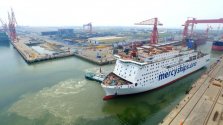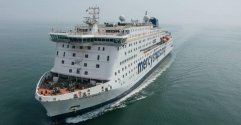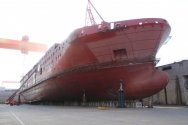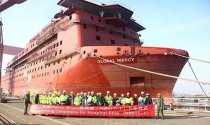@Tam
Do you know if Chinese shipyards have the technology to make LNG carriers that also tap the load for fuel?
All of them do. Every LNG carrier from Chinese shipyards do this as standard.
@Tam
Do you know if Chinese shipyards have the technology to make LNG carriers that also tap the load for fuel?
It is time to raise the RMB by 20%. Chinese products are good enough for demanding higher prices.Prices of steel is fast rising and this will cause the prices of new builds to go up.
Is China able to double its shipbuilding capacity? China's population is way bigger than that of Korea, but shipbuilding industry is just slightly bigger in terms of tonnage.Freight rates between Asia and Europe are jumping sky high. A forty footer container is now over $10,000, *gasp*. If you think this does not have a profound effect on your daily life, think again. Rising freight rates are going to mean rising costs of items you see in the store, supermarket, grocery and online.
The rise of freight rates is a direct threat to the cost of both China's imports and exports which in turn is a direct threat to its economic performance.
This is a problem that has been in the making for over a decade. The ship building boom in the 2000s led to a bust around 2010 or so. When the bust happened, orders dropped, shipyards closed. There are still many ship orders but the global fleet had its attrition. Green regulations hastened the retirement of older ships, and the rising costs of steel made it more attractive to retire older ships earlier for scrapping. Now we are scrambling to build as many new ships as we can. You can expect spill over effects as ship owners make simultaneous orders in China, South Korea and Japan because its impossible to fulfill a large order in one shipyard at the same time.
The delivery of the CMA CGN Trocadero is most timely.
Is China able to double its shipbuilding capacity? China's population is way bigger than that of Korea, but shipbuilding industry is just slightly bigger in terms of tonnage.
Is China able to double its shipbuilding capacity? China's population is way bigger than that of Korea, but shipbuilding industry is just slightly bigger in terms of tonnage.
@Tam how many more years can China commercial shipyard sustain its growth. I fear a glut is coming.There are many shipyards around the world, including in China, that closed in the last ten years due to a glut in shipping capacity and ship building. Ship building is like the fabs in the semiconductor industry --- capital intensive, easy to lose money, requires plenty of orders to survive. That's how the commercial shipbuilding industry in the US and UK got decimated over the decades in the first place.
Even shipyards in Korea are being consolidated because they are losing money, and Japan is well off from its peak during the '70s. Remember Hanjin? Their enormous shipyard in Subic Bay in the Philippines were closed.
Like semiconductor fabs, you cannot build shipyards with the huge 500 meter long plus drydocks to build the megamaxes overnight. These things take years to plan, sites specially selected and are massive infrastructure projects on their own right. The fear is that when you build the new shipyards, who is able to forecast that we might have a glut in ships and shipbuilding in the future and these new shipyards will end up having lost money once again. The shadow of the devastation caused by the glut some years ago is still with the shipping industry.
@Tam how many more years can China commercial shipyard sustain its growth. I fear a glut is coming.






